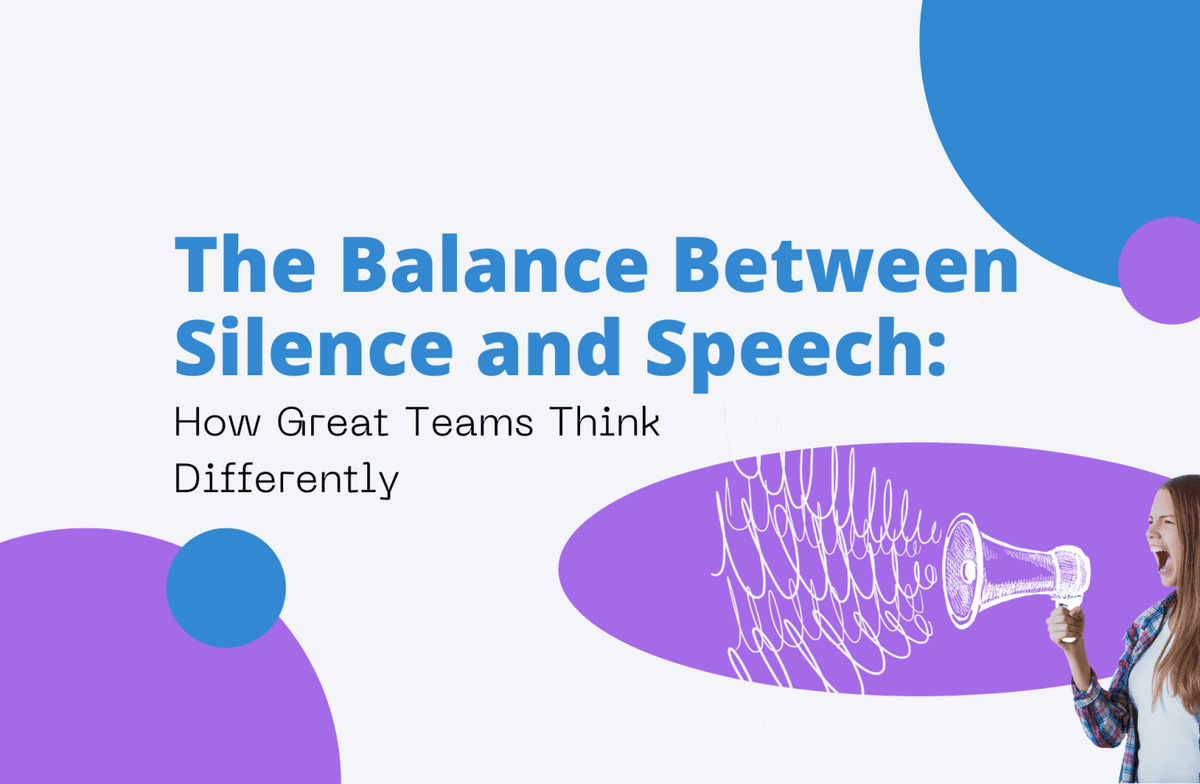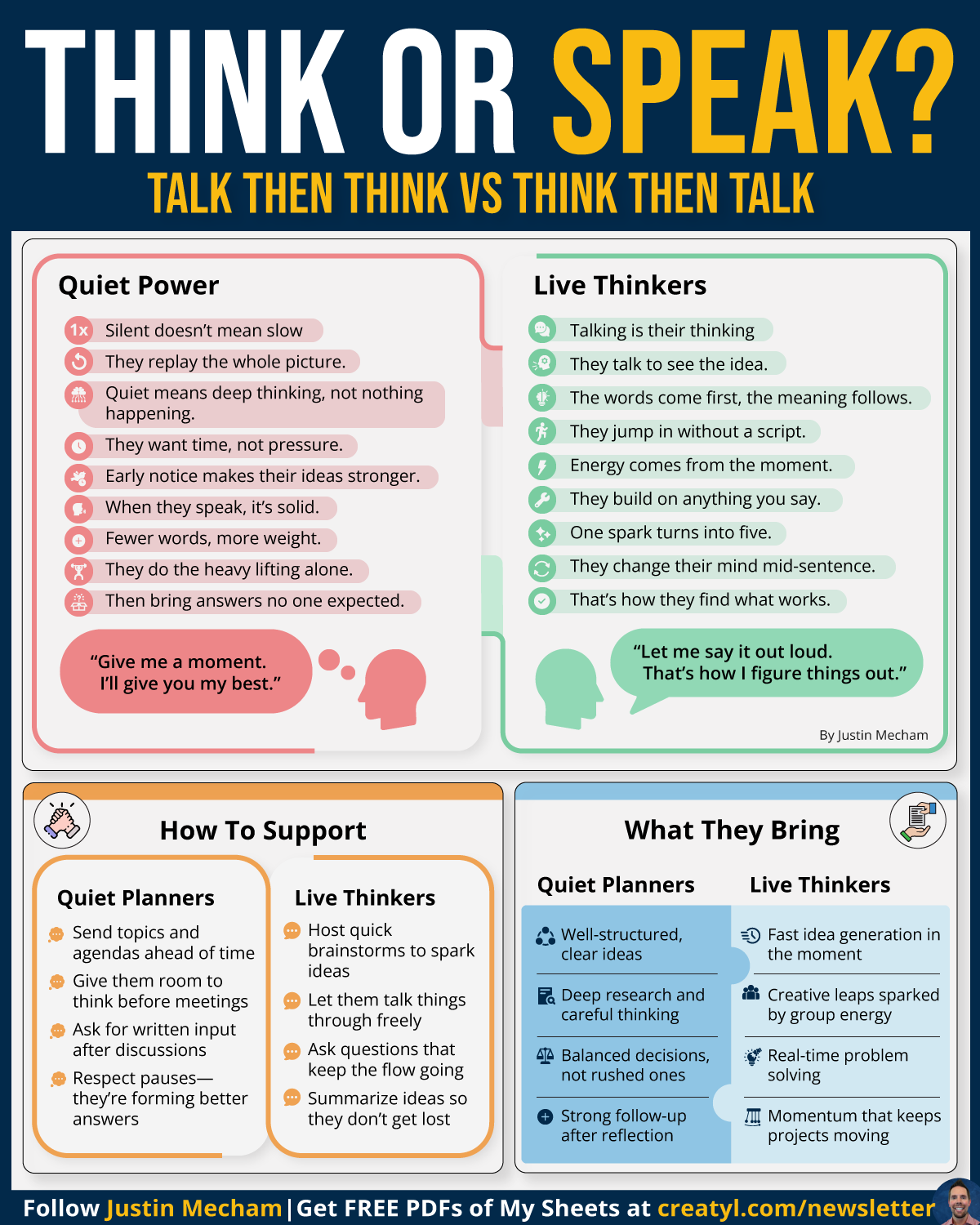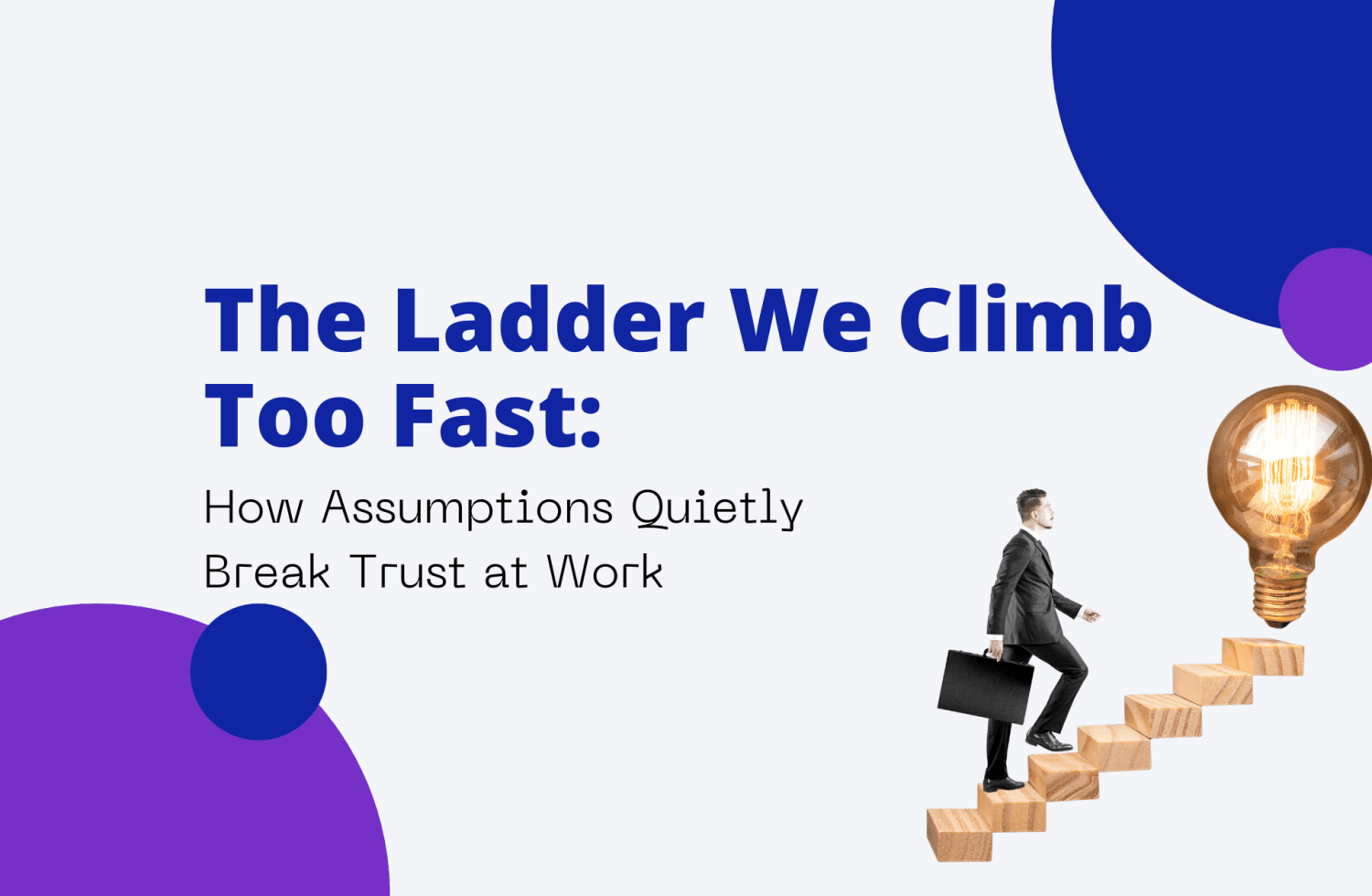Click Here to Download the PDF.
Silence doesn’t mean weakness.
And talking doesn’t mean noise.
They’re just two ways of thinking — two different rhythms in how people process the world.
Some people need space before they speak. They turn ideas over quietly until the shape feels right.
Others think best in motion — they talk through ideas as they go, discovering meaning through the sound of their own voice.
Neither is better.
Neither is smarter.
They’re simply different.
But here’s the problem: most teams only know how to work with one rhythm.
They either rush to fill silence — or leave meetings that never get off the ground.
They lose the power that happens when both styles collide in the right way.
Understanding how people think — not just what they say — is one of the most underrated leadership skills there is.
And it might be the difference between a group that meets weekly and a team that moves mountains.
This is what the “Think or Speak?” framework is all about — learning to see silence and speech not as opposites, but as allies.
Why This Matters More Than Ever
Work today moves faster than it ever has.
Deadlines are tighter, communication is constant, and the pressure to respond quickly is always on.
In that environment, the people who think before they speak often get misread.
Their pauses can look like hesitation. Their silence can look like disengagement.
But for them, silence is thinking. It’s reflection.
It’s the space where their best ideas take shape.
Then there are the ones who speak up first.
They aren’t trying to dominate — they’re trying to discover.
Talking helps them see patterns and uncover meaning. Their words are their whiteboard.
Both styles can deliver brilliance.
The challenge is that modern work often rewards one while accidentally sidelining the other.
The research backs it up.
Traditional brainstorming, where everyone shouts ideas at once, often leads to “production blocking” — when only one voice can be heard at a time, creativity stalls.
But when people write first (a method called brainwriting), the number and quality of ideas often skyrocket.
On the flip side, fast talkers drive momentum.
They create energy in a room, reveal hidden paths, and keep the wheels turning when overthinking might kill speed.
The real art isn’t choosing one.
It’s knowing when to switch gears — when to pause for reflection and when to lean into dialogue.
Great leaders build systems that allow for both. That’s where the best ideas live.
How To Support Each Style (And Why It Changes Everything)
Let’s get practical.
If you want to lead a high-performing team, you need to know how to support both Quiet Planners and Live Thinkers.
Each one brings a unique form of genius.
Quiet Planners
These are your deep thinkers.
They listen before they speak, absorb every detail, and connect dots that others miss.
They aren’t silent because they have nothing to say — they’re silent because they’re refining the right thing to say.
When they finally speak, it’s rarely random.
It’s clear. It’s considered. It’s solid.
How to support them:
- Send meeting topics and agendas ahead of time so they can process before they walk into the room.
- Start meetings with five minutes of quiet reflection — let everyone gather their thoughts before the noise begins.
- Ask for written feedback after discussions. Some of their best insights show up hours later.
- Don’t rush to fill every pause. That quiet is where their ideas form.
What they bring:
- Well-structured, grounded thinking.
- Balanced, carefully weighed decisions.
- The ability to see problems before they happen.
- Follow-through that turns ideas into action.
Quiet Planners are the ones who turn a creative spark into a working plan.
They give ideas shape and stability.
Live Thinkers
Live Thinkers are wired differently — and thank goodness for that.
They talk to find meaning.
They speak in sketches, not blueprints.
Their energy comes from the back-and-forth, and they find clarity by saying things out loud.
They don’t always know what they think until they’ve heard themselves say it.
How to support them:
- Host short, fast-paced brainstorms where ideas can move quickly.
- Let them talk things through without immediate judgment.
- Ask open-ended questions that spark new directions.
- Write things down as they speak — it helps them see their thoughts take shape.
What they bring:
- Speed, creativity, and spontaneous connections.
- A natural sense of urgency that keeps projects moving.
- The ability to pivot mid-conversation and find better routes.
- Energy that keeps a room alive when everyone else is stuck.
Live Thinkers pull ideas out of the air. Quiet Planners make them real.
When you give both what they need, you get the rare kind of magic that makes a team unstoppable.
A Real Story: When a Team Finally Found Its Rhythm
A product team I worked with had every ingredient for success: smart people, strong leadership, and a great idea.
But their process was broken.
Every meeting felt like chaos.
The Live Thinkers dominated the room — rapid ideas, fast back-and-forth, endless whiteboard scribbles.
Meanwhile, the Quiet Planners took notes, stayed quiet, and sent long messages hours later with better solutions.
By then, decisions had already been made.
The result? Frustration, rework, and missed deadlines.
They weren’t disagreeing about the work — they were just thinking on different timelines.
The tension built slowly.
The talkers were tired of circling ideas without landing anything concrete.
The quiet thinkers were tired of not being heard until it was too late.
Each meeting ended with more noise, not more clarity.
The louder voices kept pushing ahead, while the reflective ones pulled back.
No one was wrong — they just weren’t in sync.
The pattern repeated until it nearly broke the project. That’s when I stepped in.
The fix wasn’t complicated — it was structural.
Step 1: Start With Silence
I asked the team to send out a one-page brief the day before each session — the challenge, three key facts, two possible options, and one major risk.
At the meeting’s start, everyone got seven minutes of silence to read and jot down notes.
That alone changed everything.
The Quiet Planners finally had room to think.
The Live Thinkers had structure to build on. When discussion began, it was sharper, calmer, and infinitely more productive.
Step 2: Brainwriting 5–3–1
We used a technique where everyone writes three ideas in five minutes, swaps with someone else for three minutes to build on them, then marks one favorite in the last minute.
This gave every voice equal time.
No one dominated.
The best ideas rose because they were strong, not loud.
Step 3: Lightning Round
Then came 90 seconds per person to talk through their top idea — no interruptions, no debates.
The room was electric, but contained.
Everyone’s ideas got oxygen.
Step 4: Premortem & Decision Note
Before locking decisions, we asked one question: “If this failed in 60 days, why would that be?”
We listed risks, assigned owners, and finished each meeting with a short written decision note:
- What we chose
- Why we chose it
- First action
- Owner
- Review date
Step 5: Follow-Up Summary
I sent a one-page summary after every session.
That gave the Quiet Planners a chance to reflect and the Live Thinkers a clear anchor for next steps.
Within two weeks, everything shifted.
Meetings went from two hours to forty-five minutes.
Decisions got sharper.
The quietest person in the room ended up pitching the idea that became the team’s main feature.
And the energy — once chaotic — turned focused.
They didn’t just communicate better.
They started thinking together.
The Tool Kit: Simple Systems That Work
Pre-Read Template (200 words max)
- The problem in one line
- What success looks like
- Three facts that matter
- Two options we’re considering
- One big risk
- Ask: “By Friday, pick Option A or B.”
Idea Card
- My idea in one line
- What I’d test this week
- Time or cost required
- Expected result
- Main risk
Premortem Prompt
“Imagine it’s 60 days later and this plan failed. Why?”
List three reasons. Pick the top two and assign owners.
Decision Note
- What we decided
- Why it was chosen
- Who owns it
- First step
- Review date
Meeting Flow That Combines Both Styles
- Silent read and write (5–7 minutes)
- Brainwriting 5–3–1
- Lightning round (90 seconds each)
- Premortem (10 minutes)
- Decision note and recap
The flow is simple.
The impact is huge.
It gives the introvert space, the extrovert motion, and the team a shared rhythm that actually works.
The Space Between Silence and Sound
We tend to think of silence and speech as opposites — one passive, the other active.
But the truth is, both are forms of energy. They just move differently.
Silence gathers. It builds depth, focus, and perspective.
Speech releases. It builds connection, momentum, and clarity.
When teams only value the talkers, they lose the depth that holds ideas steady.
When they only value the thinkers, they lose the spark that brings ideas to life.
The best leaders don’t ask people to change who they are.
They build environments that let every kind of thinker do their best work.
Because silence isn’t weakness. And talking isn’t noise.
Both are forms of intelligence. Both are powerful ways of seeing.
The future of great work isn’t about volume — it’s about balance.
It’s about knowing when to listen, when to speak, and when to give others the space to do both.
That balance — the quiet between thought and sound — is where the real breakthroughs live.
Download the Infographic (PDF)
Want to share this with your team?
Download the “Think or Speak?” infographic as a printable PDF and use it as a guide for your next meeting.
It’s a simple visual that shows exactly how to work better with both Quiet Planners and Live Thinkers — and how the right mix of silence and speech can transform the way teams collaborate, create, and decide.




